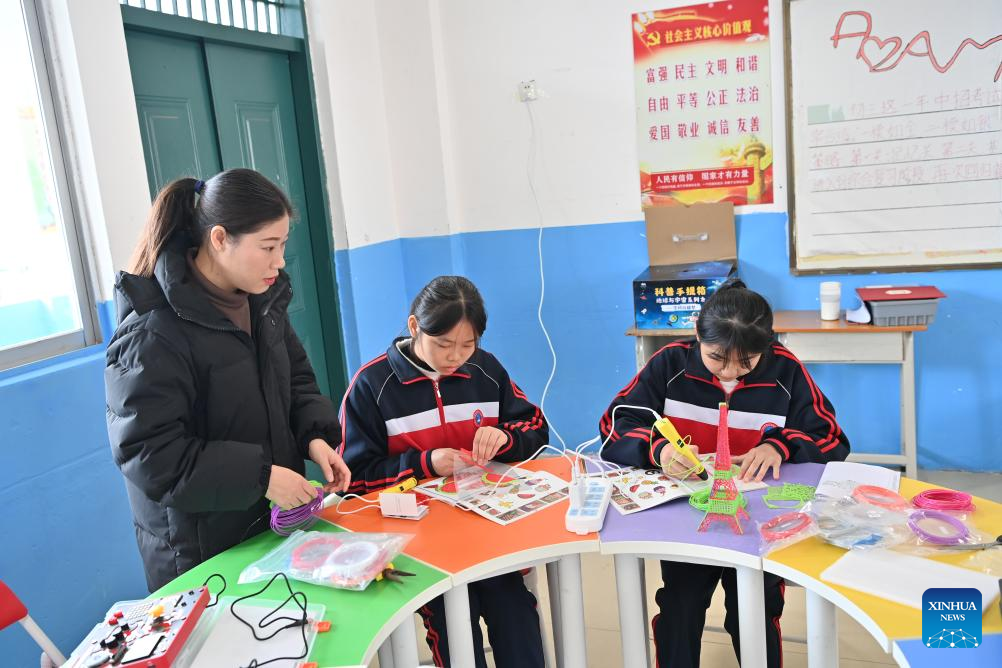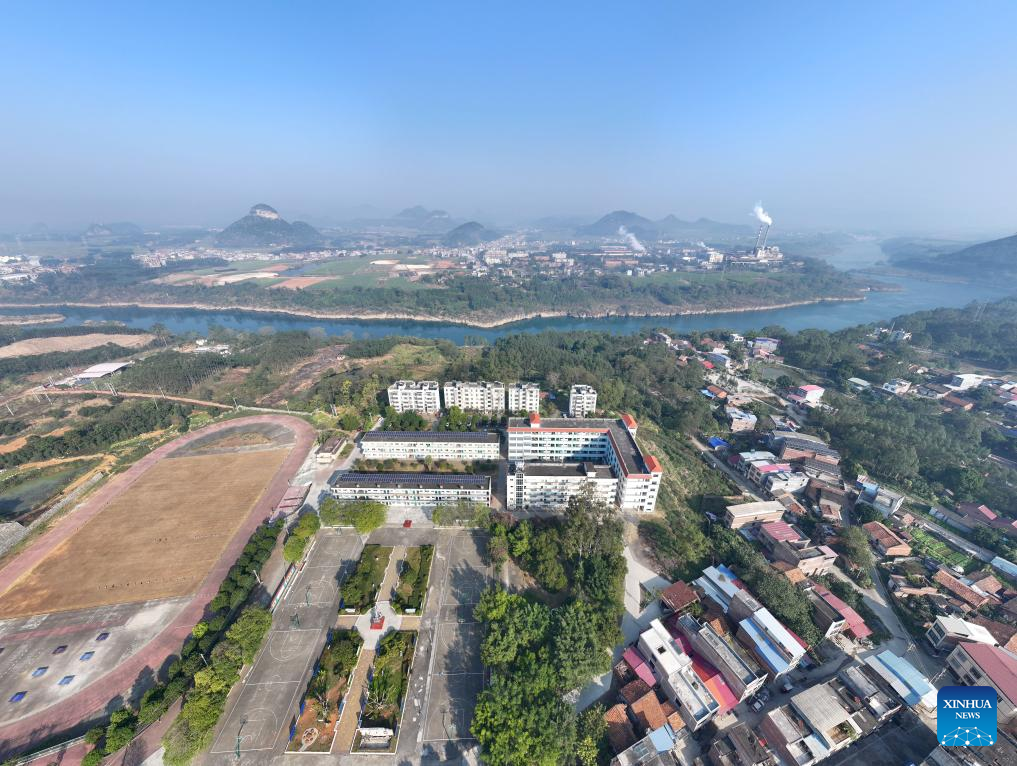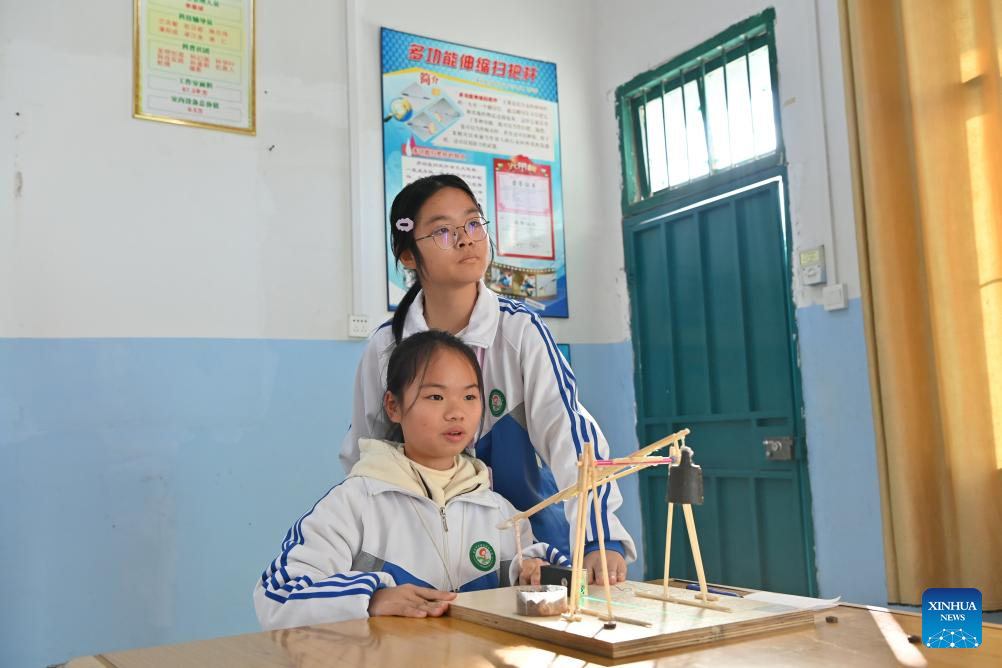
Students Xu Ziyu (C) and Nong Caihang (R) make 3D models following their teacher's guidance in Shimin Experimental School in Tiandeng County, south China's Guangxi Zhuang Autonomous Region, Dec. 27, 2023. (Xinhua/Zhou Hua)
by Xinhua Writers Bai Xu, Zhou Hua
NANNING, Jan. 26 (Xinhua) -- Huang Lichen vividly remembers her early days spent in the sugarcane fields, watching her grandmother toiling day after day in the shade of the trees.
Huang, a rural girl from Laibin City in south China's Guangxi Zhuang Autonomous Region, used to think it would be nice if sugarcane didn't have to be planted and shelled with hands.
Thanks to the "Inspiring the Future" - STEM Education for Rural Adolescents project, this ninth-grader from Qianjiang Middle School has gained the confidence to envision transforming her dreams into reality and delving into the realms of science and technology.
"Granny used to work tirelessly all year round," said Huang, adding that she aspires to become a scientist and invent intelligent robots to simplify farm work.
Huang is among the numerous children from rural China who have experienced the wonders of science and technology through the STEM project, jointly launched by the China Association for Science and Technology (CAST) and the United Nations Children's Fund (UNICEF).
Launched in 2021, the project has enabled hundreds of thousands of rural students in central and western China to participate in science and technology activities online and offline every year.
According to Zhang Yu, program manager of the Children and Youth Science Center of CAST, the project includes activities such as bringing science experts to rural areas for lectures and interactions with students, providing training to rural teachers, organizing science camps for girls, and offering support to off-campus science centers for children.
"Our project aims to combine societal efforts in delivering science and technology education resources to rural youth, enabling them to engage in extracurricular activities and enhance their knowledge and skills in science and technology," Zhang said.
Hu Yufan, a project officer at UNICEF China, told Xinhua that they would like to provide rural children with an educational experience different from their regular school curriculum to help cultivate an interest in science and technology, fostering an increased desire and confidence in learning relevant subjects.
According to last year's Chinese government work report, the contribution of scientific and technological progress to the country's economic growth has exceeded 60 percent. The Central Economic Work Conference held in December also listed priorities including advancing technological innovation to lead the development of a modern industrial system.
Last year, 10 provincial-level regions in China were covered by this project. In Guangxi alone, it has benefitted more than 20,000 students from 30 rural schools.
Encouraged by her classmates, Huang joined her school's science club. Amidst a classroom adorned with various student projects, such as rockets crafted from plastic bottles and gyroscopes made of iron wire, she gained hands-on experience in creating gravity-powered catapults and determining the angles for rocks to hit their targets.
During her summer vacation, the 15-year-old Huang took part in science camps in Beijing, marking her first venture outside Guangxi. Alongside 42 students from various parts of China, she had the opportunity to explore high-tech products and engage in conversations with students from prestigious universities.
Reflecting on her experiences, she said that her most memorable moment was talking with AI-based applications and that she was inspired to pursue studies at a university in Beijing.
In fact, the STEM project has ignited inspiration among many students like Huang in different ways.
According to 14-year-old Xu Ziyu from Tiandeng County in Chongzuo City, the experience in Beijing has been eye-opening. "Compared with Beijing, Tiandeng is relatively under-developed, so I will work hard and become a teacher in this county to help other students here," Xu said.
Xu's classmate, Nong Caihang, who is passionate about science fiction, said that she aspires to combine science and literature to craft compelling stories in the future.
Huang Qiuhui, a student at Qianjiang Middle School, cultivated a keen interest in programming and learned about it last summer by reading books and exploring the internet. "The STEM project has allowed girls from rural areas like us to envision a broader world," she said, adding that she wants to secure a computer-related job in the future.
Speaking about the significance of the project in the lives of young students, Tan Chunfu, the teacher in charge of the school's science club, said, "If I had the opportunity to participate in such a project, my life might have taken a quite different path now."
Born into a farmer's family, Tan used to help his parents cultivate sugarcane. While loading sugarcane onto trucks, he once told his dad that it would be much easier with a large machine resembling a hand to grab the sugarcane. Tan's dad dismissively snapped back, "Stop dreaming and keep working."
Now a biology teacher, he always encourages his students to pursue their scientific dreams. "Many students are like me, filled with curiosity. I hope to inspire them to explore," Tan said.
He underwent a three-day training in Beijing last October, during which he acquired novel ideas for his work, such as project-based learning where students could attempt to solve real-world problems.
Tan said he plans to launch a project-based learning program centered around sugarcane, given that Guangxi is a major sucrose production base in China, and many farmers in Laibin earn their livelihood from growing sugarcane. He aims to explore ways to help boost the incomes of the local people by reusing sugarcane leaves and residue.
"In this way, I hope to enhance the analytical and problem-solving skills of students, so that they can turn their imagination into practical solutions, rather than abandoning their ideas with regret," he said. ■

An aerial drone photo taken on Dec. 28, 2023 shows Qianjiang Middle School in Laibin City, south China's Guangxi Zhuang Autonomous Region. (Xinhua/Zhou Hua)

Students Huang Lichen (L) and Huang Qiuhui perform an experiment in Qianjiang Middle School in Laibin City, south China's Guangxi Zhuang Autonomous Region, Dec. 28, 2023. (Xinhua/Zhou Hua)



